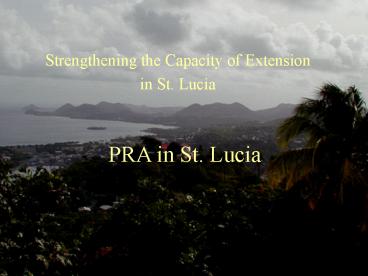PRA in St. Lucia - PowerPoint PPT Presentation
1 / 20
Title:
PRA in St. Lucia
Description:
Strengthening the Capacity of Extension in St. Lucia PRA in St. Lucia – PowerPoint PPT presentation
Number of Views:155
Avg rating:3.0/5.0
Title: PRA in St. Lucia
1
Strengthening the Capacity of Extension in St.
Lucia
PRA in St. Lucia
2
- Training
- Round 1
- Round 2
- Interim Workshop
- Next Steps?
3
TIMELINE
- INITIAL
- RECONNAISSANCE May 25 - 26
- TRAINING May 31 June 6
- PRA ROUND 1 June 8 July 13
- PRA ROUND 2 July 13 August 2
- INTERIM WORKSHOP August 9 - 10
- NEXT STE PS August, 2000 - ?????
4
TRAINING
5
ROUND 1
FIELD-WORK
DEBRIEFING
6
System 6 Root crop production
CENTRAL MARKET
PASSING BUYERS
cash
Lorry (hauling)
Minivan (Passenger)
Root crops
Dasheen
Labour
Food
17 Years
25 years
Beans
Vegetable Crops
Tree Crops
Hired Labour
Livestock
MAFF/Extension Officers
7
System 4 Banana
SLBC
JQS
Central Market
cash
Vegetables Okra
labour
food
Banana
food
labour
cash
Hired labour
8
Sample Diversity Matrix
9
System Type Vegetables
Constraints Possible Extension Opportunities Extension Action
Pest and diseases Train farmers in pest and disease management Identify farmers and problems Conduct workshops on pesticide use and safety Develop fact sheets on use and application of pesticides
Record keeping Train farmers in farm and home management 1) Develop appropriate record keeping systems 2) Cost of production of selected vegetables 3) Conduct workshops on record keeping and analysis
10
ROUND 2
FOCUS GROUPS
11
Prioritizing Constraints
12
Problems and Opportunities Matrix for Livestock
Focus Group
Problem Rank Farmer Actions
Inconsistent market 1 Form legally recognised group Individual market research Scheduled/rotational production
Improved breeds expensive 1 Form legally recognised group Buy ram and female sheep, share them among group members to improve flocks
High cost of water 2
Stray dogs 3 Neighbourhood watch Utilise proper fencing
Predial larceny 4
13
(No Transcript)
14
INTERIM WORKSHOP
15
(No Transcript)
16
FARMER CONTACTS
Round 1 Round 2 TOTAL
Region 1 35 45 80
Region 2 28 15 43
Region 3 48 11 59
Region 4 31 32 63
Region 5 39 36 75
Region 6 32 26 58
Region 7 37 23 60
Region 8 30 28 58
Totals 280 216 496
17
- 46 Ministry Staff Trained in PRA
- 280 Farmers interviewed in 8 regions
- 24 Focus group meetings
- 216 Farmers participated in focus groups
- 496 Farmer contacts in less than two months
- 31 Front-line officers including Regional Heads
- 5 Commodity Coordinators
- 7 Ministry Personnel
- 6 Project Team Members
18
- ESSENTIAL OUTCOMES
- Farmer constraints, problems, and opportunities
for diversification identified. - Establishment of actions to be taken by
individual farmers and farmer groups to address
their constraints. - Establishment of actions to be taken at the
Extension level to address farmer constraints. - Identification of Demonstration possibilities
to address farmer constraints, by region. - Farmer constraints and concerns more fully
integrated in Extension programme planning
process.
19
Extension Programme Planning Before and After PRA
Before After
Farmers input was limited, top- down, based on
Ministry policy, guidelines and directives. No
need assessment undertaken. farmers not fully
aware of Ministry policy and what role they have
to Play. More abstract programmes designed by
Extension Officers based on their own perceptions
of farmer constraints.
More farmer involvement and participation from
bottom-up. More inward looking, more farmer
centered. Programs have more input from the
farming community. Constraints analysis, farmer
identified solutions and actions ensure more
realistic programmes.
20
Next Steps































